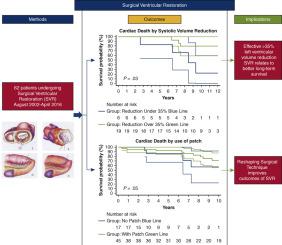The Journal of Thoracic and Cardiovascular Surgery ( IF 4.9 ) Pub Date : 2020-05-23 , DOI: 10.1016/j.jtcvs.2020.04.167 Guglielmo Stefanelli 1 , Alessandro Bellisario 2 , Marco Meli 1 , Emilio Chiurlia 1 , Andrea Barbieri 3 , Luca Weltert 2

|
Objective
The study objective was to evaluate the short- and long-term outcomes of patients with ischemic cardiomyopathy after surgical ventricular restoration and to identify risk factors related to poor results.
Methods
Between August 2002 and April 2016, 62 patients affected by ischemic cardiomyopathy underwent surgical left ventricular restoration at our unit. Patients' mean age at operation was 63 years (39-79 years). Mean ejection fraction was 29.6%. The Surgical Treatment for Ischemic Heart Failure trial criteria have been used as indications for surgery. Fifty-seven patients (91%) received surgical myocardial revascularization. Mitral valve repair was performed in 39 patients (63%). The surgical technique consisted of the classic Dor operation or a different approach reducing the equatorial diameter of the left ventricle and avoiding the use of a patch. The data were analyzed retrospectively for perioperative results and short- and long-term clinical outcomes.
Results
One patient died of noncardiac causes within 30 days (1.6%). All-cause death occurred in 36 patients (58%) during follow-up (0.6-14.7 years; median follow-up time, 7.02 years), of whom 15 died of cardiac causes. Age, need for preoperative intra-aortic balloon pump, reduction less than 35% of postoperative left ventricular end-diastolic and end-systolic volumes, type of surgical technique, and ejection fraction less than 25% were identified as risk factors for late cardiac mortality. Perioperative levosimendan administration and presence of preoperative moderate to severe mitral regurgitation influenced early and intermediate-term outcomes, but no statistical relevance on long-term results was demonstrated.
Conclusions
Patients with ischemic dilative cardiomyopathy have favorable short- and long-term outcomes after ventricular restoration. Age, preoperative ejection fraction less than 25%, inadequate left ventricular surgical reverse remodeling, and type of surgical technique negatively affect long-term survival.
中文翻译:

缺血性心肌病手术心室修复后的结果
客观的
研究目的是评估缺血性心肌病患者在手术心室修复后的短期和长期结果,并确定与结果不佳相关的危险因素。
方法
2002 年 8 月至 2016 年 4 月期间,62 名缺血性心肌病患者在我们单位接受了手术左心室修复。患者的平均手术年龄为 63 岁(39-79 岁)。平均射血分数为 29.6%。缺血性心力衰竭的手术治疗试验标准已被用作手术的指征。57 名患者 (91%) 接受了手术心肌血运重建。39 名患者 (63%) 进行了二尖瓣修复。手术技术包括经典的 Dor 手术或减少左心室赤道直径并避免使用补片的不同方法。回顾性分析数据的围手术期结果和短期和长期临床结果。
结果
一名患者在 30 天内死于非心脏原因(1.6%)。随访期间(0.6-14.7 年;中位随访时间为 7.02 年),36 名患者(58%)发生全因死亡,其中 15 人死于心脏原因。年龄、需要术前主动脉内球囊泵、术后左心室舒张末期和收缩末期容积减少小于 35%、手术技术类型和射血分数小于 25% 被确定为晚期心脏死亡的危险因素. 围手术期给予左西孟旦和术前存在中度至重度二尖瓣关闭不全影响早期和中期结果,但没有证明长期结果具有统计学相关性。
结论
缺血性扩张型心肌病患者在心室恢复后具有良好的短期和长期预后。年龄、术前射血分数低于 25%、左心室手术逆向重塑不足以及手术技术类型对长期生存产生负面影响。











































 京公网安备 11010802027423号
京公网安备 11010802027423号